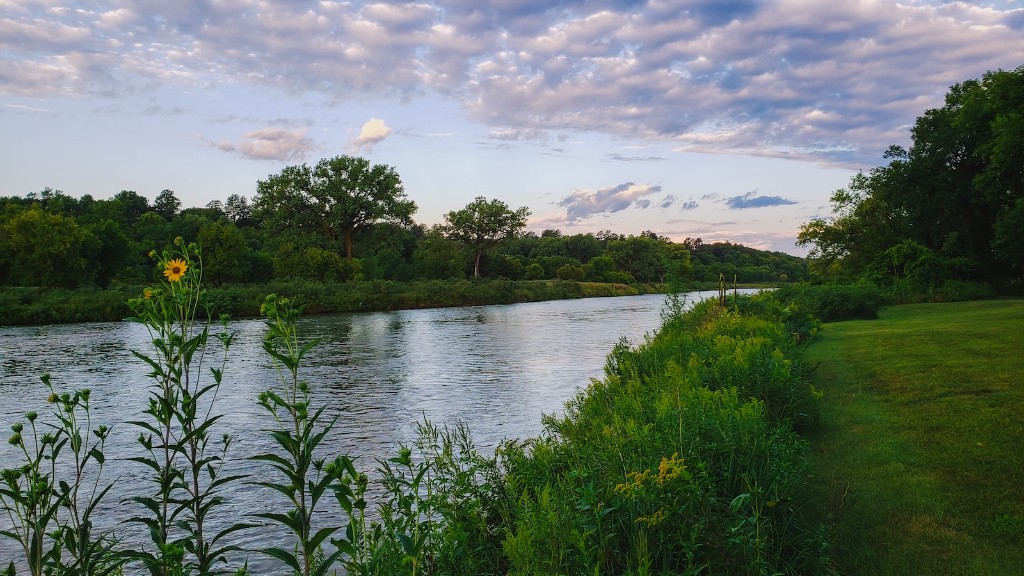Rivers that Flow into the Mississippi River
The Mississippi River is the second longest river in the United States, stretching from Minnesota to the Gulf of Mexico. This mighty river drains an impressive 31 states and two Canadian provinces as it winds its way through and around them. Through its tributaries, America’s great rivers, both natural and man-made, come together and flow into the Mississippi River.
The Missouri River is one of the Mississippi’s most prominent tributaries. Originating in the Rocky Mountains of Montana, the Missouri winds its way through the Great Plains, joining the Mississippi at St. Louis. At over 2,500 miles long, it is the longest river in the United States and over 120 miles of the river is part of the Missouri-Mississippi Confluence. The Missouri drains more than 500,000 square miles of land and supplies over 40% of the water flowing into the Mississippi.
The Ohio River is also one of the Mississippi’s principal tributaries. At over 1,000 miles long, it is the second longest river in the United States. It begins in Pennsylvania and travels through Ohio, Kentucky, Indiana, and Illinois, before finally entering the Mississippi at Cairo, Illinois. The Ohio River Valley is considered by many to be the birthplace of the United States, and its inputs are crucial to the health of both the Ohio and the Mississippi.
The Arkansas River is the Mississippi’s third largest tributary. It begins in Colorado and flows eastward through Kansas and Oklahoma, joining the Mississippi at Arkansas City, Arkansas. At over 1,500 miles long, the Arkansas has been vital to the development of the Great Plains and its historical importance is frequently referenced in local mythology and folklore.
The Red River is another important tributary of the Mississippi. Rising in northern Texas, it winds its way through Louisiana and into the Mississippi at Simmesport, LA. The Red River has always been an important trading and transportation hub, and its access to the Mississippi gave settlers and traders a transportation channel to the Gulf of Mexico.
The Minnesota, the Wisconsin, and the Illinois are also major input rivers to the Mississippi. While they may not be as long or as well-known as the Missouri or the Ohio, they are essential to the health of the Mississippi.
While the Mississippi has long held an important role in American history and development, it’s tributaries have had an even more profound impact on the growth of the United States. From the exploration of the West to the development of infrastructure for transportation and industry, America’s great rivers, both natural and man-made, have played an integral part in the country’s growth and prosperity.
Effects of Dams and Diversion Projects on Mississippi River’s Tributaries
The effects of dams and diversions on the tributaries of the Mississippi River have been profound. Hundreds of dams and diversion projects have been built over the past century, altering the flow of streams and rivers, reducing the amount of water entering the Mississippi, and influencing aquatic habitats.
These effects have been especially evident in the Missouri and Arkansas River basins, where more than 70 major dams have blocked, diverted, or regulated flow across thousands of miles of rivers. As a result of these water control projects, millions of acre-feet of water have been removed from the watershed and channeled away from the mainstem of the river and its tributaries.
The effects of these projects on the rivers and tributaries have been far-reaching, from affecting fish and wildlife populations to altering water quality. For example, the construction of large reservoirs has decreased the amount of dissolved oxygen in the water, which in turn has caused an increase in the amount of certain pollutants.
In addition to the alteration of water quality, the construction of dams and diversions has also impacted species migration and abundance. As reservoirs trap sediment, they can reduce the amount and quality of sediment available for fish spawning areas and disrupt the natural flow of nutrients downstream.
In recent decades, numerous organizations and agencies have redoubled their efforts to restore balance to these rivers and tributaries. From providing more access to tributaries for recreational fishing, to increasing spring flows in rivers to improve spawning areas for fish, to reintroducing beaver populations to help restore riparian habitats, these and other conservation efforts are making a difference on the rivers that feed into the Mississippi.
Ultimately, a healthy Mississippi River watershed will depend on the health of its tributaries. All of the rivers that contribute to the Mississippi play a vital role, from providing sustenance to communities to providing habitats for fish and wildlife.
Economic Benefits of Mississippi River’s Tributaries
The tributaries of the Mississippi River have long provided a variety of economic benefits to cities and towns along the river. From providing water for drinking and industry to powering electric generating plants, these rivers are essential to the American economy.
The Ohio River, in particular, has long been a major source of economic activity in the Midwest. From providing electricity to power cities and steel mills, to becoming a major navigation channel for goods and services, the Ohio has long been a navigable waterway for commercial and recreational purposes.
Additionally, the tributaries of the Mississippi have proven invaluable for the development of energy resources. Numerous hydroelectric dams have been built on the tributaries of the Mississippi, providing clean, renewable energy to the region. Over 20% of the energy generated in the Midwest is derived from hydroelectric power.
The economic benefits of these tributaries are also felt in recreational activities. From fishing to boating to camping to wildlife viewing, these rivers provide a variety of activities for people to enjoy. Local businesses along the rivers benefit from the influx of visitors to the area, as these rivers have become tourist destinations.
Similarly, agricultural activities along the rivers are heavily dependent on the availability of water. Most of the corn, wheat, and other crops that are grown in the region rely on the abundance of fresh water that the tributaries of the Mississippi provide.
From providing economic benefits to powering energy generating plants to providing recreational opportunities, the tributaries of the Mississippi are essential to the region’s well-being and prosperity.
Environmental Effects of Mississippi River’s Tributaries
The tributaries of the Mississippi have long played an important role in the health of the environment. They have been responsible for providing vital nutrients to the river and its ecosystem and they have been essential in maintaining the water quality of its many tributaries.
The rivers that flow into the Mississippi have been responsible for supplying an abundance of nutrients to the mainstem, providing essential food and habitat for aquatic life. In addition, their flow has also been a vital part of maintaining water quality throughout the watershed, helping to maintain the ecological balance.
As the population of the Midwest has grown over the last century, many of the tributaries of the Mississippi have been polluted by runoff from factories and farms. In particular, the Missouri River has been heavily impacted by agricultural runoff, resulting in an increase in the amount of sediment, nitrates, and other pollutants in the water.
Furthermore, the construction of dams and diversions on the tributaries has caused an increase in the amount of water removed from these rivers and streams, resulting in a decrease in the amount of water available to aquatic life and wildlife. The effects of these projects have been wide-ranging, from affecting fish and wildlife populations to altering water quality.
Fortunately, numerous organizations and agencies have begun to take steps to restore balance to these rivers and tributaries. From restoring access to lost spawning areas, to reintroducing beaver populations to their natural habitats, these conservation efforts have made a difference in restoring the health of the Mississippi River watershed.
Importance of the Mississippi River’s Tributaries’ Health in Humans’ Health
The health of the tributaries of the Mississippi River is inextricably linked to the health of humans. The contamination of these rivers and streams with pollutants, sediment, and nitrates can lead to a host of health problems for humans that live along these rivers.
The impact of contaminated water on human health is often under-reported. Contaminated water can lead to a variety of illnesses in humans, from gastrointestinal issues to respiratory issues. In addition, pollutants in the water can cause developmental problems in newborns and can lead to an increased risk of cancer.
In addition to the direct effects on human health, contaminated water can also be a contributing factor to poor mental health. Living in a polluted environment can lead to a variety of mental health issues, including depression and anxiety.
Finally, water contaminated with pollutants can have a profound effect on the local economy. Loss of water quality can lead to decreased tourism, decreased property values, and other economic losses.
The health of the Mississippi River’s tributaries is essential to the health of humans and the environment. Protecting these rivers and streams from pollution and providing clean water to communities is essential to the health of the region.
Conservation Efforts for Mississippi River’s Tributaries
The conservation of the tributaries of the Mississippi has been an ongoing effort for many years. Numerous organizations and agencies have been working to restore balance to these rivers and tributaries. From providing more access to tributaries for recreational fishing, to increasing spring flows in rivers to improve spawning areas for fish, to reintroducing beaver populations to help restore riparian habitats, these and other conservation efforts are making a difference on the rivers that feed into the Mississippi.
In addition to conservation efforts, numerous organizations have been working to restore balance to these rivers and tributaries through the implementation of best management practices. This includes the implementation of conservation tillage, cover crops, rotational grazing, and other practices that can help reduce runoff and soil erosion.
Finally, numerous organizations have been working to restore balance through the use of wetlands restoration. By restoring wetlands along rivers, streams, and tributaries, organizations can help reduce the amount of polluted runoff entering the Mississippi and its tributaries.
Ultimately, a healthy Mississippi River watershed will depend on the health of its tributaries. By restoring balance to these rivers and tributaries, organizations and agencies can help ensure the health of the watershed and the health of its people.





